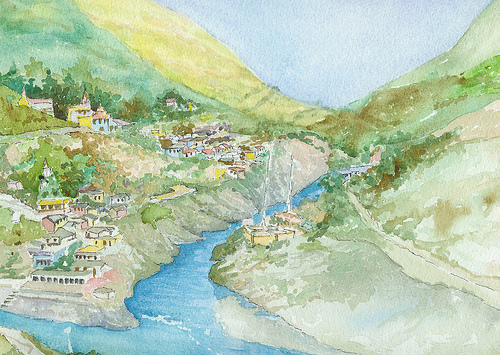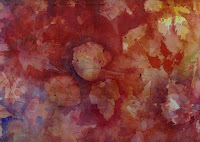
Friday, March 6, 2009
Subscribe to:
Post Comments (Atom)
THREE WOMEN

This was a part of my experiment to reuse & recycle discarded building materials found on some of my job sites. i painted This piece on a 2' x 2' gypsum board (also known as drywall) with a border of 1" x 1" ceramic tiles. The women are dressed in traditional kumaoni pichora (head scarf), with mangal sutra & bindi a must have for a married kumaoni women (bindi=red dot, mangalsuatra=beaded necklace)
Dev prayag

Devprayag is the point where, Bhagirathi River and Alaknanda River join to form Ganges River. It is one of the five sacred confluences in the Himalayas and is an important place of pilgrimage for devout Hindus.
MY CHOICE OF PAINTS, PAPER, BRUSHES
Watercolors are inexpensive, easy to find and easy to handle. They aren't too messy, and don't require an elaborate setup. Most people are familiar with watercolors through school projects, etc. I call it a " Green Product" as it is an environmental friendly medium.
I Like to work on Arches watercolor paper which has been milled in Lorraine, France since 1492. Arches watercolor paper has been used to publish the complete works of Voltaire and Napoleon’s Description of Egypt. For over five hundred years Arches fine art paper has been the choice of fine artists all ver the world.
Windsor & Newton a company established in 1832 are my favourite pigments, known for their high quality, they preserve well with time. On their website one can see a virtual museum of their history. You can create a beautiful piece of art by mixing just the basic primary colors Red, Blue & Yellow in this medium.
Chandrashekhar Pant
OF THE FORGOTTEN DHRUPAD EXPONENT
Article from Blog of RAJSHEKHAR PANT
http://pant.rediffiland.com/iland/pant_diary.html
“Despite spending a huge sum from the taxpayers pocket in maintaining a large entourage of bureaucrats along with several handpicked experts of art and culture our government and officials may have forgotten Pt Chandrashekhar Pant, yet among those in hills who love classical music he continues living for ever and ever.” Says Chandra Pant, an octogenarian literator from Bhimtal having to his credit the authorship of a much celebrated novel ‘tune kaha tha’, “inspire by the life and music of Chandrashekhar Maharaj, with natural literary digressions here and there.”
Born on Nov 22, 1912 in a remote village called Khantoli in Almora district, Pt Chandrashekhar Pant was an internationally acknowledged exponent of Dhrupad –a particular style of singing the exponents of which are quite limited now. Patronized by Raja Mansingh Tomar of Gwalior, this particular school of singing is said to have its roots in Sam Veda. During the ‘East West Music Encounter’ in 1964 the inborn talent of Pt Pant was acknowledged and appreciated by stalwarts like Yahudi Manuhin and Nicholas Novokov.
Dahgar brothers, themselves the renowned Dhrupadists, paid moving tributes to him on several occasions and well known names like Dr Keshlikar, Ahmadjan Thirakua, Harinarayan Mukhopadhyay, Dr Ratanjankar happened to be his fans once. Mahesh Pande, a young vocalist from the university of Delhi doing the first ever research work on Pt Pant under Dr Mrs Krishna Bisht –herself a disciple of Pt Pant –says in an exclusive interview “Actually the life, deeds and heart of Pt Pant all sang together. A scholar of Sanskrit from Pune, besides that of the music, he spent his youth as a Sanyasi (recluse) in Uttar Saket near Dwarahat in Kumaon; had a brief sojourning in Nainital in early fifties, where he remained actively associated with ‘Sharda Sangh’ –a musical society which now has virtually no memoirs of Pt Pant. In the second half of fifties he became a producer of classical music in the AIR New Delhi, which surprisingly has but one of his recordings. The last phase of his brief life (1959-1967) was spent in the Univ of Delhi as a reader in the department of music.” Mahesh has been trying hard to collect information regarding Pt Pant so that, “The musical journey of this great exponent may be made available at a single source. Let this legend in the field of music not pass into oblivion because of official apathy,” he says. A musical society called Swar Sangam from the foothill city of Haldwani celebrates the Jayanti of Pt Pant every year.
Article from Blog of RAJSHEKHAR PANT
http://pant.rediffiland.com/iland/pant_diary.html
“Despite spending a huge sum from the taxpayers pocket in maintaining a large entourage of bureaucrats along with several handpicked experts of art and culture our government and officials may have forgotten Pt Chandrashekhar Pant, yet among those in hills who love classical music he continues living for ever and ever.” Says Chandra Pant, an octogenarian literator from Bhimtal having to his credit the authorship of a much celebrated novel ‘tune kaha tha’, “inspire by the life and music of Chandrashekhar Maharaj, with natural literary digressions here and there.”
Born on Nov 22, 1912 in a remote village called Khantoli in Almora district, Pt Chandrashekhar Pant was an internationally acknowledged exponent of Dhrupad –a particular style of singing the exponents of which are quite limited now. Patronized by Raja Mansingh Tomar of Gwalior, this particular school of singing is said to have its roots in Sam Veda. During the ‘East West Music Encounter’ in 1964 the inborn talent of Pt Pant was acknowledged and appreciated by stalwarts like Yahudi Manuhin and Nicholas Novokov.
Dahgar brothers, themselves the renowned Dhrupadists, paid moving tributes to him on several occasions and well known names like Dr Keshlikar, Ahmadjan Thirakua, Harinarayan Mukhopadhyay, Dr Ratanjankar happened to be his fans once. Mahesh Pande, a young vocalist from the university of Delhi doing the first ever research work on Pt Pant under Dr Mrs Krishna Bisht –herself a disciple of Pt Pant –says in an exclusive interview “Actually the life, deeds and heart of Pt Pant all sang together. A scholar of Sanskrit from Pune, besides that of the music, he spent his youth as a Sanyasi (recluse) in Uttar Saket near Dwarahat in Kumaon; had a brief sojourning in Nainital in early fifties, where he remained actively associated with ‘Sharda Sangh’ –a musical society which now has virtually no memoirs of Pt Pant. In the second half of fifties he became a producer of classical music in the AIR New Delhi, which surprisingly has but one of his recordings. The last phase of his brief life (1959-1967) was spent in the Univ of Delhi as a reader in the department of music.” Mahesh has been trying hard to collect information regarding Pt Pant so that, “The musical journey of this great exponent may be made available at a single source. Let this legend in the field of music not pass into oblivion because of official apathy,” he says. A musical society called Swar Sangam from the foothill city of Haldwani celebrates the Jayanti of Pt Pant every year.




No comments:
Post a Comment